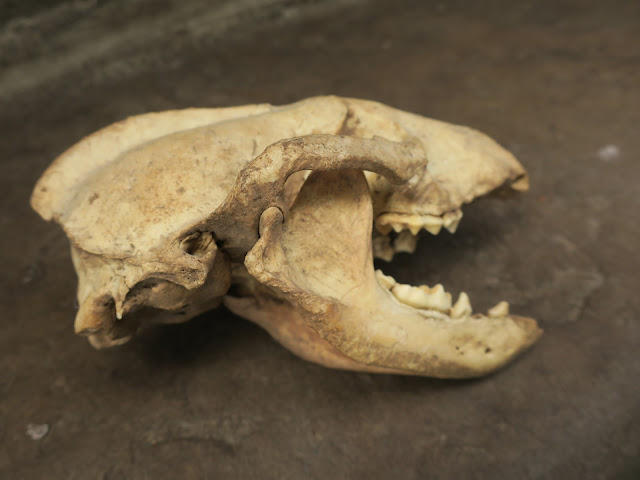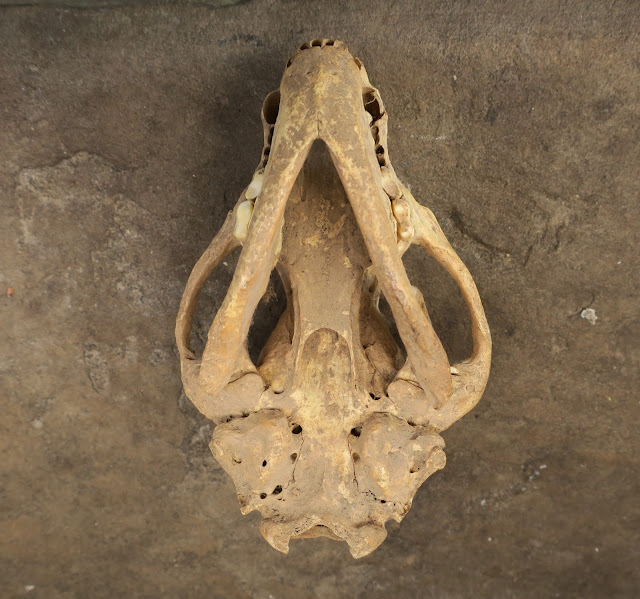One of the suggestions in my downloaded pack is to make a nature table - and there's a squared chart with suggestions of what to put on it . . . feathers and fur, petals and grasses . . . I'm not going to be doing that but if I concentrate, I find my house is already a sort of modest nature table so in the spirit of the challenge I thought that, over the course of the month, I'd introduce you to a few of the things I have lying around.
Every so often I mention iSpot for the interest of people who have not already come across it. It was started by OPAL and the Open University. The idea is that when you take photographs of plants, insects, birds, fungi, mammals, fish . . . you can upload them. If you know what you've seen, you say. If not, others will help with the ID. It's free to use and the agreement is that the Open University can use the photos you've submitted if it finds them useful. In the process, an interesting catalogue of natural history is accumulating.
I confess I can't work out how iSpot works in different countries. The UK and Ireland go together. That much is clear. But when I looked at contributions under the heading 'Help With Global Identifications' I found a couple from South Africa, one from Scotland and one from Berkshire (which is in England). I'm not sure what 'global' means then in this context. And I'm assuming it doesn't work from everywhere. But for those in the UK and Ireland (and South Africa) it's very useful. If you are accessing it from other parts of the world . . . well, I don't know. Maybe there's a way the site can tell where you are and you will get appropriate instructions. Try it. (And perhaps you will let me know how you get on?)
1. Here's something you might like to do as one of your own wild-life related activities; enter for the 'Isolation Wildlife Photography Awards'. The closing date is June 8th 2020. There are no prizes. The organisers are hoping the challenge in itself and the quality of the judges will draw you in.
2. The latest addition under the 'Identifying Things' tab at the top of the blog is the People's Trust for Endangered Species - Key species and habitat index page. (How to offer practical help to creatures like hedgehogs and chafer beetles along with information about other projects which aim to support animals like Tamarind monkeys and stop the trade in rhino horn.)
It's not too late to join '30 Days Wild'. Click the badge to register.
 |
| 30 DAYS WILD Today's act of random wildness is to put bones on a nature table. |
Tweet
Here's a link to iNaturalist . Similar in intent to iSpot and used by people in the USA and South Africa and other places round the world.
Here's a link to iNaturalist . Similar in intent to iSpot and used by people in the USA and South Africa and other places round the world.








20 comments:
Thanks for the reminder about iSPOT, Lucy. It's a wonderful resource! I should use it more often - I've had a lot of help from that source in identifying fungi in the past
In North America, it is called iNaturalist. I use it quite frequently.
Hello
The skull is cool, I have never seen a real badger. I heard they are mean animals. The website iSpot sounds helpful. Wishing you a happy day and week ahead!
Lucy you have been busy posting and I have enjoyed reading them all back to where I was last - it's like opening a good book and knowing there is time to read before my lunch today.
Your observations are the crux of your posts, always so well illustrated and often with useful links (30 days wild; iSpot) and interesting bits of information. Your interest in the natural world draws my interest too and because you have of necessity had to occupy a small space recently you have been able to observe at close quarters what many of us overlook. In fact you are achieving what Ted Hughes advises would-be poets to practice -"concentration on a small point, letting your imagination work freely to collect everything that might concern that still point"t
A treasure of a skull - I would think the teeth are going to confirm the ID.
Whichever creature it belongs to I'm really enjoying your virtual nature table - it was my favourite part of school days!
Interesting post and pictures. I'm glad you mentioned how long it is as I did wonder. iSpot looks like a useful resource. xx
That's very interesting to see these different skulls ! Makes me think of Halloween lol !
Well, Lucy, what a brilliant idea. I have been reliving my Silver Birch Tree Following days for #30DaysWild Day 3 prompt on 'Encounter' from Dr Miriam Darlington's Fb page. I'm still tweaking my post, but it will go up soon-ish. Thank you for your recent comment: much appreciated. I hope you are doing OK: you are certainly putting your usual powers of initiative and close observation to good use!
South Africa migrated all its old observations to iNaturalist a few years ago. Now the emphasis comes from California rather than the UK.
https://www.inaturalist.org/observations/48115350
Lovely photos of the skull.
Hello Phil. I enjoy using iSpot. It's not only helpful to me when I don't know what something is, I feel glad to be 'useful' in submitting photos and enjoy seeing some of the surprising plants and insects and fungi submitted by others. It's also a celebration of the 'ordinary' and as you can imagine, I appreciate that!
Hello David. And thanks for the info. I've now added a link to iNaturalist to the post.
Hello Eileen. I've seen badgers several times - they are hefty animals and reported to be quite dangerous if cornered. (Though I can't say I've ever heard of anyone actually having been harmed by one.)
Hello Laura. I'm glad you have enjoyed catching up. I don't think schools do nature tables now but can't imagine why not. They are brilliant at getting children to notice things and as an early way of learning their names. My primary school education was in a very urban area but we still had a nature table. (And grass snakes in a tank in the classroom. Even frogs spawn.)
Hello Mike. I'm waiting for the weather to go back to sunny so I can take the skull outside an re-photo it beside a ruler. Yes. iSpot is a really good site. Do explore it. You don't have to belong to explore the photos people have uploaded.
Hello Gattina. They are photos of the same skull taken from different angles. I hope you didn't feel it was too gruesome to see them. The skull is very old. The badger is long dead. I find it very interesting to see something that is usually completely hidden behind flesh and hair.
Hello Caroline. I think several of us developed a lasting affection for the first tree we 'followed'.
Hello Diana. I have added a link to the iNaturalist site to the post. Thank you for the link to the badger skull. It must have been very exciting for the person who posted it to have come across it in the grass. The skull I collected is of the 'in the family, always been there' variety so I don't have a proper context for it. I must see if I can find out more about that!
Lucy, Miriam Darlington left this for you on my blog... "
Lucy Corrander, if you get this, I've enjoyed your posts too - that badger skull is an aged badger - you can tell from its pronounced sagittal crest; the ridge on the skull that gets larger with age. Do follow my #30dayswildcreativity if you like."
Hello Crafty Green Poet. Thank you. There's something very attractive about this skull, isn't there?
Hello Caroline. Thank you for passing on the message. I have found Miriam on twitter and am now following her there.
Post a Comment